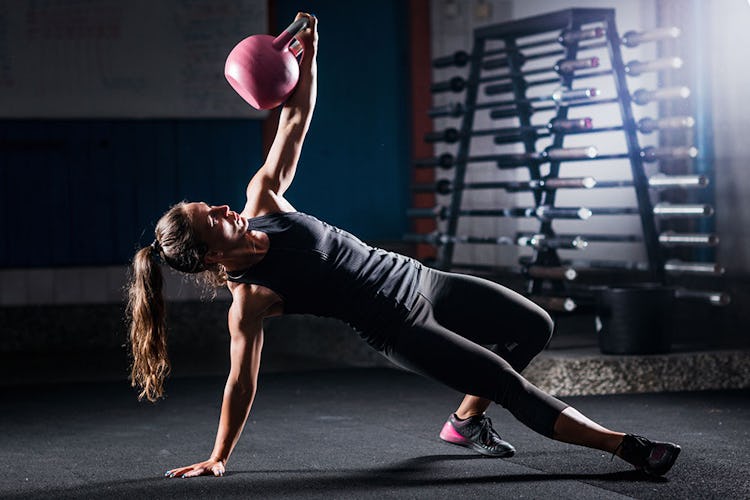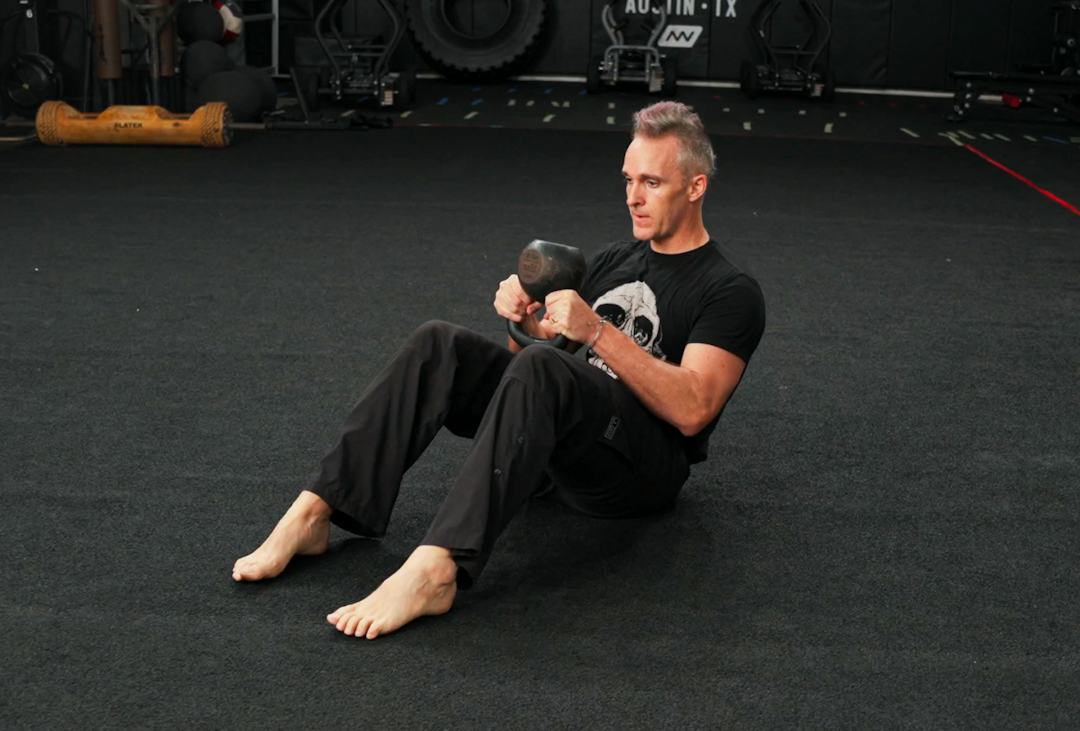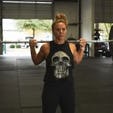Kettlebells are renowned for their ability to strengthen the entire body with numerous functional exercises, but many people don’t think of them for ab training to build a summer-ready body. Sure, bodyweight exercises like situps and crunches can help get you there, but kettlebells can carve up your core just as quickly, and they offer a lot of other benefits at the same time that you can’t get with direct ab work alone.
If you’ve got only one moderate-weight kettlebell at home, you have more than enough to get an outstanding six pack. Allow us to present some of our favorite kettlebell ab exercises, and a workout that puts them all together.
Benefits of Using Kettlebells to Work Out Your Abs
If you’ve ever trained with kettlebells, you learned one thing very quickly—EVERY exercise you do with a kettlebell is automatically a core exercise too. Due to the offset nature of the load—that is, the distance from the kettlebell’s center of gravity (the middle of the bell) to the weight’s handle, as well as your body—kettlebells are hard to control and require your whole body to stabilize every movement. Creating that stability causes your abs to brace hardcore—no pun intended—so, to a large degree, you’re getting great core training with virtually any kettlebell exercise you perform, be it an overhead press, a clean, a swing, or anything else.
A study in the Journal of Fitness Research found that subjects training with kettlebells increased their core strength by 70% following an eight-week program. (One of the exercises used was the Turkish getup, which we’ll show you below.)
With all this said, you can also target the abs with certain kettlebell exercises that put tension on the ab muscles more directly, resulting in greater muscle size gains in your six pack. That will help to make your abs visible—assuming, that is, that your nutrition is on point so that your body fat is low. Before we go any further, understand this: no matter how strong and muscular your abs are, you won’t see them if they’re covered in body fat. Aim to get yours under 10% if you want to see your abs pop to their full potential. (If you need help setting up a diet that allows you to do this, see our article, How To Set Up Your Diet for Fat Loss or Muscle Gain.)
Five Amazing Kettlebell Ab Exercises
We asked Shane Heins, Onnit’s Director of Fitness Education, and a veteran kettlebell coach, for his five favorite kettlebell moves for the core, and he suggested the following.
1. Kettlebell Windmill
(See 04:56 in the video above)
The windmill works hip flexibility, shoulder stability, and core strength at the same time, making for one seriously challenging movement.
Step 1. Hold the kettlebell in your right hand at shoulder level. Your elbow should be tight to your side and your forearm vertical (this is called the rack position). Angle your feet 45 degrees to the left. Press the kettlebell straight overhead.
Step 2. Brace your abs like you’re about to take a punch to the gut. Kick your right hip out to the side so you feel a stretch on the back of your right leg. Bend both knees slightly.
Step 3. Turn your head to look up at the kettlebell and keep your eyes on the weight as you bend your hips back to the right and lower your torso toward the floor. Allow your left arm to slide down the inside of your left thigh as you descend. Go as low as you can control, and then come back up.
2. Half-Quad Pull-Through
(See 07:35 in the video)
Many exercise scientists argue that the abs’ main function is to brace the spine while the limbs move around, and that’s exactly what this exercise has you doing. Can you keep your shoulders, back, and hips straight and braced while you drag the kettlebell back and forth across the floor beneath you? You’ll feel your back, shoulders, and legs burn on this one.
Step 1. Get on all fours and place a kettlebell to the outside of your left hand. Brace your abs and raise your knees off the floor so your weight is supported by your hands and toes. Your body should form a straight line from your head to your pelvis.
Step 2. Extend your left leg back until it’s straight. Reach your right hand behind your left to grasp the kettlebell and drag it across the floor to the outside of where your right hand was on the floor. Try to keep your shoulders and hips square to the floor as you do this. Turn the handle around so you can grasp it easily with the left hand on the next rep, and bring your left leg back up and lower both knees to all fours again.
Step 3. Extend your right leg, and pull the kettlebell through with your left hand.
3. Roll-Down To Pullover Extension
(See 08:20 in the video)
While this move may look like a classic situp at first glance, there’s so much more going on. Heins says that while conventional situps and crunches shorten the core muscles, this exercise strengthens them while it lengthens them, forcing you to contract your abs hard while you extend your spine—the opposite of how most people train them.
Step 1. Sit on the floor holding a kettlebell upside down with both hands on the horns of the handle. Have your knees bent and your feet flat on the floor as if you were in the top position of a situp.
Step 2. Tuck your pelvis under and slowly roll your back down to the floor, beginning with your tailbone. To make this easier, hold the kettlebell a little further away from your body so it serves as a counterbalance.
Step 3. Keeping your tailbone tucked under and your core braced, reach the kettlebell over and behind your head—try to go to where your arms are straight.
Step 4. Bring the kettlebell back in front of your chest and slowly roll your body back up to the starting position.
4. Turkish Getup with Twist
(See 10:15 in the video)
Every kettlebell course in the world teaches this one. The getup is a full-body movement that builds strength, mobility, and conditioning all at once, but it’s your core muscles that tie it all together. This move may not have your abs burning like a set of crunches does, but you can rest assured it will target your six pack and obliques, and the addition of a twisting motion at the end will emphasize the latter even more.
Step 1. Lie back on the floor with the kettlebell in your right hand and your right leg bent with your foot on the floor. Extend your left arm at 45 degrees and plant your hand on the floor for stability. Press the weight overhead and curl your body off the floor, using your hand for assistance, until your weight is supported on your left forearm.
Step 2. Extend your left arm so your palm is your base. Press through your right foot so your hips rise and slide your left leg back underneath you so you can rest on your left knee. Now straighten your torso so you’re in a tall kneeling position with the kettlebell held overhead.
Step 3. Lower the kettlebell to the rack position and twist your torso to the right, extending your left arm as if you were throwing a punch with your left hand. Your fist should end up outside your right leg.
Step 4. Reverse the twist and bend at the hips to lower your torso. At the same time, press the weight up again. Plant your left hand on the floor, kick your left leg through so it’s straight and flat on the floor again, and lie back on the floor to return to the starting position.
All of the above is one rep.

5. Half-Quad Renegade Row
(See 11:40 in the video)
The renegade row is another move familiar to kettlebellers everywhere, but this modification makes it even more challenging. As with the half-quad pull-through, the half-quad renegade row makes you stabilize on a small base of support while one arm lifts weight. It’s meant to be done with two kettlebells, but you can use one if that’s all you have, and rest your other hand on a block or step that’s about the same height as a kettlebell.
Step 1. Kneel on the floor and grasp two kettlebells. Turn their handles so they’re angled in about 45 degrees and press them into the floor. Raise your knees off the floor so your weight is supported by the kettlebells and your toes.
Step 2. Extend your left leg back, and shift your weight into the left-hand kettlebell. Row the right-hand kettlebell, retracting your shoulder blade as you lift it.
Step 3. Lower the kettlebell, switch legs, and repeat the row on the other side.
How To Stretch Your Core Before Working Out
You know that you should warm up and stretch out a bit before any workout, but how do you do that for abs? They’re not muscles that stretch like the hamstrings or pecs. Still, they can be trained for greater flexibility with movements that also warm up your whole body and prepare it for challenging training. Heins put together a prep routine that helps to activate your core while lengthening its muscles. If you spend most of the day slumped over a computer or a smartphone, your ab muscles get used to being in a shorter position and will tighten up accordingly. These exercises help to restore length while integrating the core’s many functions.
Follow the exercises listed below (and demonstrated in the video above, starting at 1:56), performing them as a circuit. Do reps of each exercise in sequence for 30 seconds each, and then repeat for 2 total circuits.
1. Lying Spine Twist (02:30 in the video above)
2. Kneeling Arm Thread (02:44)
3. Child To Up Dog (02:51)
4. Up Dog Twist (02:59)
5. Kettlebell Around the World (03:10)
Get Shredded With This Balanced Kettlebell Ab Workout

After you’ve warmed up, perform the five kettlebell exercises we introduced above together as a circuit. Do 10 reps of each move (5 reps per side for unilateral exercises) in sequence, and then rest 60 seconds. Repeat for 3–5 total rounds. If you’re a lady, an 8 to 12-kilo kettlebell is probably appropriate (18–26 pounds). If you’re a dude, start with a 12 to 16-kilo bell (26–35 pounds).
(See 03:41 in the video above)
1. Kettlebell Windmill
Reps: 5 each side (10 reps total)
2. Half-Quad Pull-Through
Reps: 5 reps each side (10 reps total)
3. Roll-Down To Pullover Extension
Reps: 10
4. Turkish Getup with Twist
Reps: 5 each side (10 reps total)
5. Half-Quad Renegade Row
Reps: 5 each side (10 total)
How Often Should You Train Your Abdominals?
The abs are a somewhat unique group of muscles in that they work to stabilize the spine in virtually any exercise you do, so you don’t need to hit them directly any more frequently than you would chest, legs, or any other muscle group to see gains. They’re also limited in their ability to grow like those other muscles are, so there’s no benefit in training them every day (like old-school bodybuilders used to) in order to make them “pop”.
You can work your abs directly with the routine we gave here up to twice per week, avoiding any other direct ab training for at least three days in between sessions. You can also incorporate one or two of each of the kettlebell ab exercises listed into your existing workouts for other muscle groups, doing some ab training in the beginning of the session (if you really want to prioritize the core), or at the end.

)





